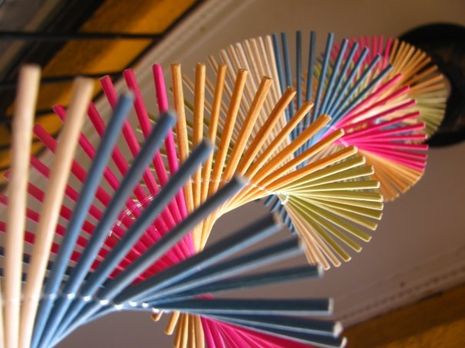From Hockney to Hawking: The intersection of art and science
Rachel Duke offers a new perspective on the age-old STEM vs Humanities debate

As we all know, CamFess is the place to go for spirited and nuanced discussion and none seems to inspire us quite like the ‘STEM vs humanities’ debate. Which is harder? More important? Has the most attractive cohort? Art and science are often perceived as mutually exclusive fields; artists and scientists could not be more different. But are the two really such disparate and distinct disciplines and, by treating them as such, are we missing out on opportunities?
Science has been an object of fascination for many authors, screenwriters, and artists. Many great novels such as Mary Shelley’s ’Frankenstein’ or ’Brave New World’ by Aldous Huxley, and popular films including ’Star Wars’ and ’Jurassic Park’ require a union of these two great ideas: science and fiction. ’The Imitation Game’ and ’The Theory of Everything’ are made because of our fascination with the dramatisation of science.
“Art is no stranger to the laws of mathematics.”
However, science has done more than simply inspire, it is often fundamental in the creation of art, with scientific and mathematical principles appearing in art more frequently than one might expect. Just one example of this is the golden ratio, defined as the ratio between two numbers of approximately 1.618. It is special because numbers in a Fibonacci sequence (a sequence where each number is the sum of the two preceding numbers i.e. 1,1, 2, 3, 5, 8, 13) approach the golden ratio. The golden ratio appears a great deal in the natural world including in the shells of sea creatures, the DNA double helix, and even in spiralling galaxies. Why is this important in art? Humans are naturally drawn to balance meaning, consciously or unconsciously, many artists use it to create aesthetically pleasing works. The compositions of Leonardo Da Vinci’s The Last Supper and The Mona Lisa use the golden ratio to position the disciples and the elements of the Mona Lisa’s face. Brands are no strangers to the golden ratio with Apple, Pepsi and Shell all famously using logos that are proportioned using the golden ratio. Famous works of architecture such as the Sagrada Familia, the Taj Mahal and the Parthenon all contain elements (including windows, domes and columns) that adhere to the golden ratio in relation to other components. Art is no stranger to the laws of mathematics.
Modern science is also helping us uncover the secrets of art history. Any fans of the BBC show ‘Fake or Fortune’ will have seen how the experts at the Courtauld Institute can use science to prove the authenticity of a painting. Chemical pigment analysis has been used to detect many forgeries, for example, ‘Titanium white’ was only introduced in the early 20th century so its presence can indicate a forgery if the artist painted before this date. Infrared imaging and X-rays can reveal the brush strokes underneath the finished painting that can reveal how the composition developed. Science allows us to view art like never before.
How will science’s continued involvement in art impact its future? Artificial intelligence (AI) presents both opportunities yet poses a very real threat to the visual and literary arts. AI analyses patterns in existing artworks or pieces of writing to create new pieces of art tailored to specific needs. This raises concerns about originality, the ethical implications of plagiarism and copyright of existing art, and the impact on artists’ livelihoods.
“For a long time, science simply meant observing and drawing.”
However, it is very much a two-way street; art has also had a profound impact on science. The phrase ‘summarise this paragraph in a Figure’ will be very familiar essay feedback to my fellow Bio-NatScis who know better than anyone that a picture is worth a thousand words. Art has been used since the dawn of research to illustrate scientific observations and theories. Da Vinci created detailed anatomical drawings of ‘The Vitruvian Man’ and human organs. Darwin’s famous ‘I think’ sketch of the tree of life serves as a visual description of a scientific principle as complex as evolution. Detailed observations of human physiology and Haeckel’s depictions of marine invertebrates informed the creation of early phylogenetic trees depicting the relationships between different species. For a long time, science simply meant observing and drawing.
Today, the office walls of researchers are adorned with detailed microscopy images of intracellular structures and neural networks in the brain. Not only are these scientific images beautiful, but they act as sources of inspiration and are important in encouraging public engagement with science, especially with young children. Images of black holes, distant planets, and the 1969 moon landing are often cited as part of the reason astronauts embarked on the career path they did. Similarly, an image can cross language barriers. This is one of the reasons diagrams are used in scientific and medical informative texts such as the leaflet that describes how to do a COVID-19 test.
Is our desire to make science aesthetically beautiful a good thing? Well, the textbook diagrams certainly perpetuate misconceptions, though an overcrowded image of a cell is, of course, not conducive to learning a metabolic pathway. In 2021, Nature suggested that up to one-fifth of published life-sciences papers contain at least one digitally altered image, and we’ve all heard horror stories like that of Jonathan Pruitt who, in a quest for beautiful graphs, fabricated data in at least 17 publications claiming that social spiders had personalities, shaping the field of behavioural ecology as we know it. Though journals are becoming increasingly stringent with this, it is always worth remembering that data is not always as beautiful as we might hope- and that’s okay!
Ultimately, both art and science rely on imagination and novel thinking to produce something, whether that is a beautiful painting or an elegant hypothesis. Science always has and continues to benefit from the involvement of artists that increase the ease of scientific communication and, in exchange, scientific advancements push the boundaries of art. Both disciplines can inspire and change the way we view the world around us. So, maybe we need to take a leaf out of Da Vinci’s book and learn to view science and art as two sides of the same coin.
 News / Cambridge study finds students learn better with notes than AI13 December 2025
News / Cambridge study finds students learn better with notes than AI13 December 2025 News / Cambridge Vet School gets lifeline year to stay accredited28 November 2025
News / Cambridge Vet School gets lifeline year to stay accredited28 November 2025 Science / Did your ex trip on King’s Parade? The science behind the ‘ick’12 December 2025
Science / Did your ex trip on King’s Parade? The science behind the ‘ick’12 December 2025 News / Uni Scout and Guide Club affirms trans inclusion 12 December 2025
News / Uni Scout and Guide Club affirms trans inclusion 12 December 2025 Arts / Modern Modernist Centenary: T. S. Eliot13 December 2025
Arts / Modern Modernist Centenary: T. S. Eliot13 December 2025









